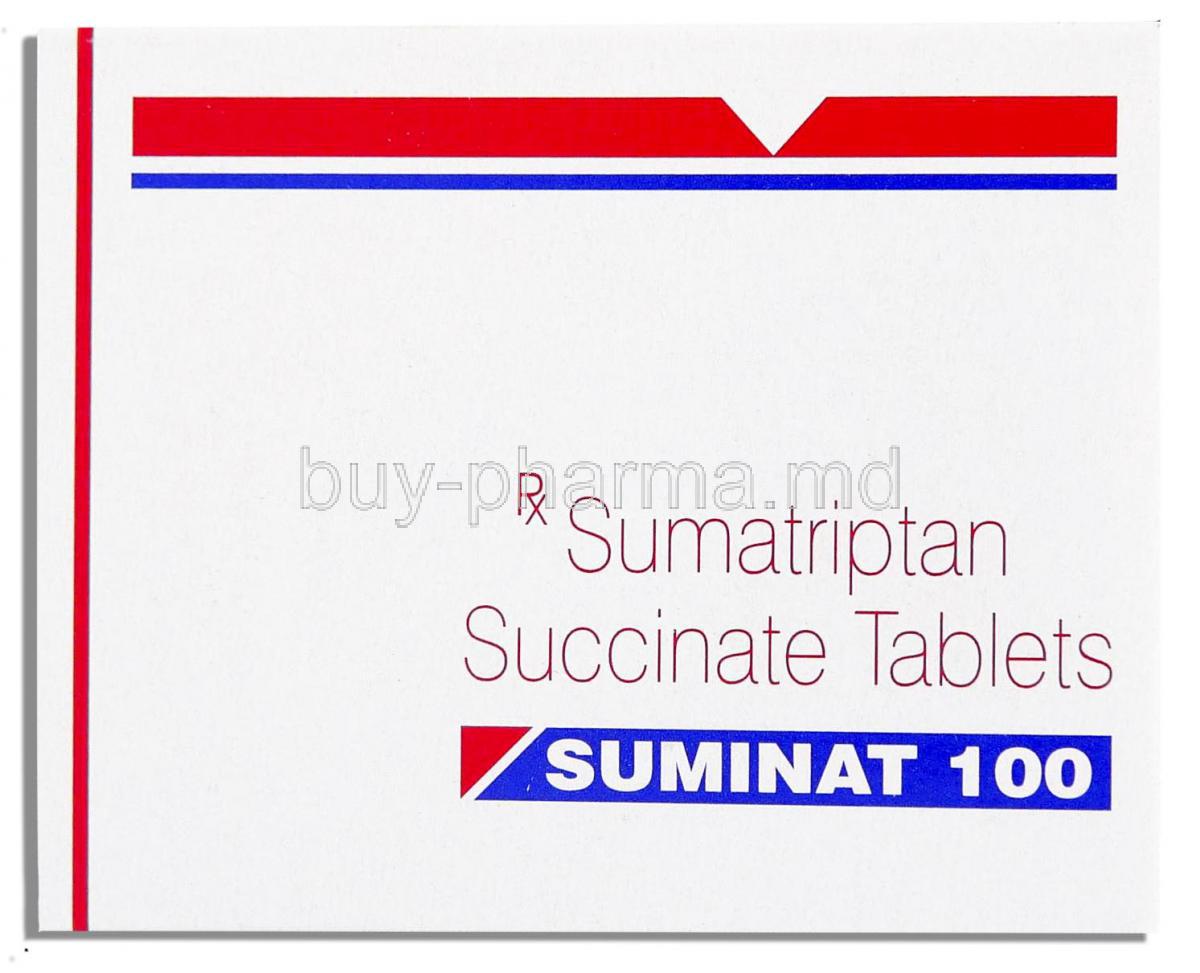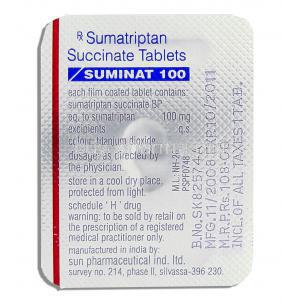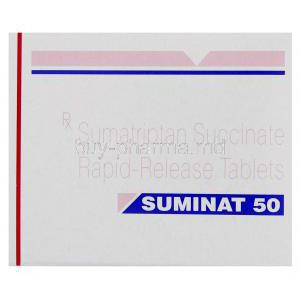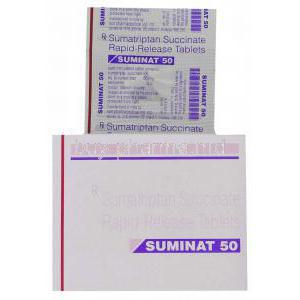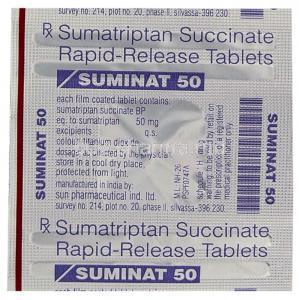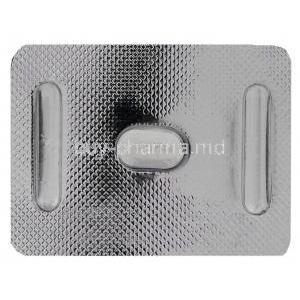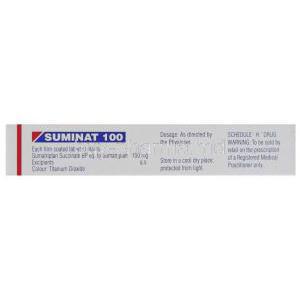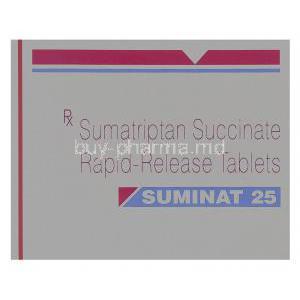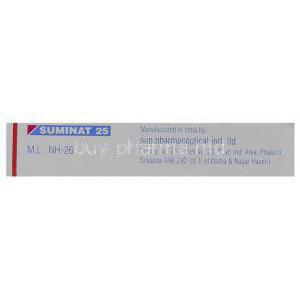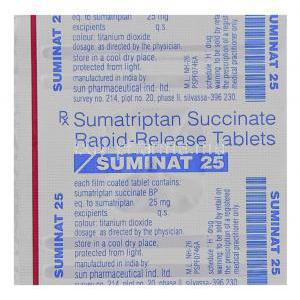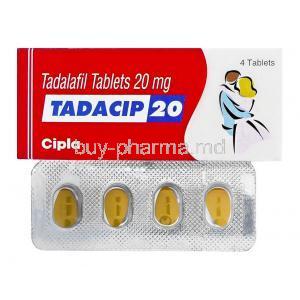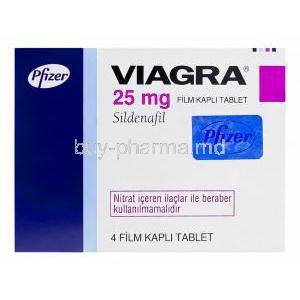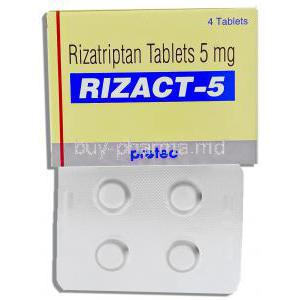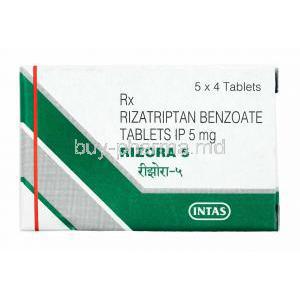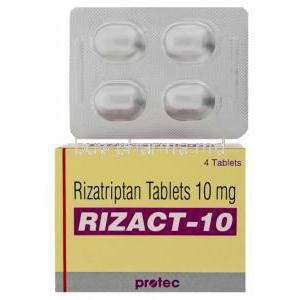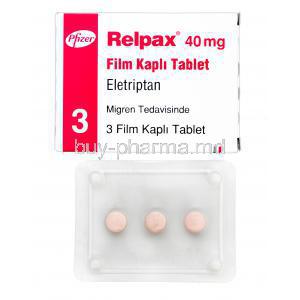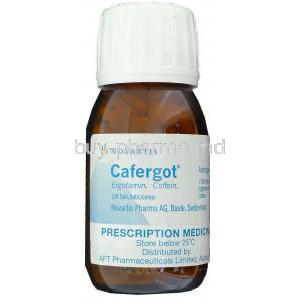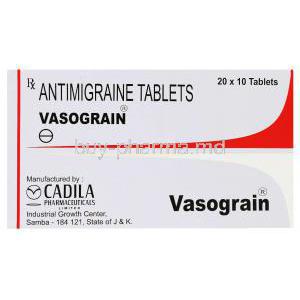Introduction to Suminat (Sumatriptan)
Overview of Suminat and its therapeutic role
Suminat, containing the active compound sumatriptan, is a therapeutic agent classified under the triptan family. It is primarily designed to combat the acute episodes of migraine and cluster headaches. This medication provides rapid relief by targeting the fundamental vascular and neurological mechanisms underlying these debilitating conditions.
Brief history and development of sumatriptan
Sumatriptan was pioneered in the late 20th century, marking a milestone in migraine pharmacotherapy. Prior to its introduction, treatment options were limited and often unsatisfactory. Its advent revolutionized headache medicine, offering patients targeted relief instead of generalized pain control.
Importance of triptans in migraine management
Triptans are considered indispensable in modern neurology. Their ability to alleviate pain, reduce inflammation, and restore neurological stability positions them as first-line treatment for acute migraine management. For many patients, triptans provide the difference between hours of incapacitation and rapid restoration of daily function.
Composition and Formulations
Active ingredient: Sumatriptan succinate
The pharmacologically active constituent of Suminat is sumatriptan succinate, a selective serotonin receptor agonist. Its potency and specificity provide targeted intervention in migraine pathophysiology.
Available dosage forms (tablet, nasal spray, injection)
- Oral tablets – convenient and widely used for outpatient care
- Nasal spray – rapid absorption for patients with nausea or vomiting
- Subcutaneous injection – fastest onset of action for severe or urgent cases
Strengths and packaging information
Suminat is available in multiple strengths, including 25 mg, 50 mg, and 100 mg tablets, as well as nasal sprays and pre-filled syringes. Packaging is designed for portability, ensuring accessibility during sudden headache onset.
Sumatriptan and ibuprofen
Sumatriptan is a triptan that works on serotonin receptors to relieve migraines, while ibuprofen is a nonsteroidal anti-inflammatory drug (NSAID) that reduces pain and inflammation.
Sumatriptan and lexapro
Taking sumatriptan (a migraine medication) and Lexapro (an antidepressant) together can increase the risk of a serious condition called serotonin syndrome, which involves high serotonin levels and symptoms like confusion, agitation, increased heart rate, sweating, and muscle problems.
Rizatriptan vs sumatriptan
Pain relief is typically faster with Rizatriptan rather than with Sumatriptan. A 10 mg Rizatriptan dosage may be expected to take effect in as little as 30 minutes. The Sumatriptan dosage is significantly higher at 100 mg, typically taking nearer to an hour to offer effective relief from migraine symptoms
Ubrelvy vs sumatriptan
Ubrelvy (ubrogepant) is a CGRP receptor antagonist that is safer for people with heart conditions, while sumatriptan (Imitrex) is a triptan that is a first-choice treatment but can cause dangerous heart-related side effects. Ubrelvy works differently and is a good option if sumatriptan is not suitable. Both are oral medications used for acute migraine attacks, but sumatriptan is also available as a nasal spray and injection.
Nurtec vs sumatriptan
Nurtec (rimegepant) is a CGRP receptor antagonist for acute migraine treatment and prevention, while sumatriptan (Imitrex) is a triptan for acute treatment only, with faster-acting forms available
Naratriptan vs sumatriptan
Sumatriptan can be taken again 2 hours after the first dose if needed, but naratriptan requires a 4-hour wait before a second dose. Sumatriptan starts working within about 2 hours, whereas naratriptan can take up to 3 or 4 hours to reach its maximum effect.
Frovatriptan vs sumatriptan
Frovatriptan has a longer half-life compared to Sumatriptan, which means its effects last longer. It is often used for menstrual migraines due to this characteristic. On the other hand, Sumatriptan acts faster but its effects do not last as long.
Mechanism of Action: How Suminat Works
Action on serotonin (5-HT1B/1D) receptors
Suminat binds selectively to serotonin receptors, particularly 5-HT1B and 5-HT1D, which are located in cranial blood vessels and sensory nerve endings. This receptor specificity underpins its effectiveness.
Vasoconstriction of cranial blood vessels
Migraine pain is often associated with vasodilation. Sumatriptan induces controlled vasoconstriction, alleviating pulsating pain and restoring vascular balance.
Inhibition of pro-inflammatory neuropeptide release
By preventing the release of calcitonin gene-related peptide (CGRP) and substance P, Suminat reduces inflammation in meningeal tissues. This mitigates pain and sensitivity during migraine episodes.
Restoration of normal brain signaling during migraine attacks
Through its dual vascular and neurochemical action, Suminat helps stabilize abnormal neuronal firing, restoring normal communication pathways in the brain.
Suminat Uses
Primary Indications
- Acute treatment of migraine attacks with or without aura
- Relief of associated symptoms such as nausea, light sensitivity, and sound sensitivity
- Acute treatment of cluster headaches, a condition characterized by excruciating unilateral pain
Off-label Uses
- Management of menstrual migraines resistant to conventional therapy
- Relief of postdural puncture headaches
- Treatment of rare headache syndromes such as SUNHA (short-lasting unilateral neuralgiform headache attacks)
- Occasional use in status migrainosus under specialist supervision
Sumatriptan Dose and Administration
Dosage varies by formulation and patient profile. Sumatriptan dose for migraine:
- Tablets: Initial dose of 25–100 mg, repeatable after 2 hours if symptoms recur.
- Injection: 6 mg subcutaneously, with a second dose after 1 hour if necessary.
- Nasal spray: 20 mg, may repeat after 2 hours if symptoms return.
Sumatriptan max dose should not exceed 200 mg in 24 hours for oral forms. Patients with hepatic or renal impairment require dose adjustments. If a dose is missed, it should be taken only when the next attack begins, not as a preventive measure.
Storage and Handling Precautions
- Store at controlled room temperature between 20–25°C.
- Protect from excessive moisture and direct sunlight.
- Keep injectable forms in their original packaging to prevent contamination.
- Dispose of expired products responsibly through approved collection systems.
Sumatripan Side Effects
Common Side Effects
- Flushing and transient warmth
- Tingling sensations
- Drowsiness or lightheadedness
- Nausea, vomiting, and gastrointestinal upset
- Generalized fatigue or weakness
Sumatriptan Adverse effects
- Chest tightness or pressure mimicking angina
- Increased blood pressure
- Irregular heartbeat or palpitations
- Severe hypersensitivity reactions such as rash, swelling, or anaphylaxis
Sumatripan Interactions
- Contraindicated with MAO inhibitors due to prolonged drug clearance
- Caution with SSRIs and SNRIs because of potential serotonin syndrome
- Should not be combined with ergotamine derivatives
- Possible interaction with beta-blockers such as propranolol
- Avoid concomitant use with other triptans within 24 hours
- sumatriptan and alcohol may intensify sedation or dizziness
Sumatripan Contraindications
- Hypersensitivity to sumatriptan or any formulation component
- History of cerebrovascular accident or transient ischemic attack
- Coronary artery disease or ischemic cardiac conditions
- Uncontrolled or severe hypertension
- Peripheral vascular disease
- Concurrent therapy with ergot-type alkaloids
Warnings and Important Precautions
Cardiovascular safety concerns
Sumatriptan exerts vasoconstrictive activity, which may precipitate cardiovascular complications in predisposed individuals. Patients with a known history of coronary artery disease, arrhythmias, or uncontrolled hypertension must exercise heightened vigilance. Periodic cardiac evaluation, including stress testing, may be advisable before initiating therapy in at-risk populations.
Risk of overuse headache (medication-overuse headache)
Excessive reliance on triptans can paradoxically trigger rebound headaches. This phenomenon, termed medication-overuse headache, typically emerges in individuals using acute migraine therapy more than 10–15 days per month. The result is a cycle of escalating frequency and diminished response to treatment.
Precaution in patients with liver or kidney disease
Hepatic metabolism and renal clearance play pivotal roles in sumatriptan elimination. Patients with impaired hepatic or renal function should receive adjusted dosing, or in severe cases, avoid use altogether. Routine laboratory monitoring of liver enzymes and renal markers is prudent in long-term users.
Potential for drowsiness affecting driving or machinery use
Neurological side effects such as drowsiness, vertigo, and reduced cognitive sharpness may impair alertness. Patients are advised to refrain from driving vehicles or operating heavy machinery until their individual response to therapy is established.
Limiting use to avoid dependency
Though not classically addictive, reliance on frequent administration can foster psychological dependence. Physicians recommend reserving sumatriptan for acute attacks and avoiding prophylactic or routine use.
Migraine not responding to sumatriptan
If a migraine isn't responding to sumatriptan, you should contact your doctor to discuss alternative treatments, which could include a different form of sumatriptan, another type of triptan, a combination of a triptan with an NSAID, or newer medications like CGRP inhibitors. It's also possible that timing or the type of sumatriptan is the issue, and your doctor can help determine the best approach for your specific migraine attacks.
Careful Administration in Special Populations
Administration to Elderly Patients
Advancing age brings heightened cardiovascular vulnerability. Elderly patients face amplified risks of myocardial ischemia and cerebrovascular events.
- Increased cardiovascular risk: Advanced arteriosclerosis and diminished vascular elasticity predispose elderly patients to complications.
- Dose considerations and monitoring: Initial doses should be conservative, with close observation of hemodynamic response.
- Alternative therapies if contraindicated: Non-triptan options such as NSAIDs or preventive regimens may be favored when cardiac risk is substantial.
Administration to Pregnant Women and Nursing Mothers
Data regarding use in pregnancy remain limited. Sumatriptan traverses the placental barrier, raising concern for fetal exposure.
- Safety data and risk-benefit considerations: Prescribing should be reserved for cases where untreated migraine poses greater harm than drug exposure.
- Placental transfer and fetal exposure: Animal studies suggest minimal teratogenicity, yet controlled human data are scarce.
- Excretion into breast milk and breastfeeding guidance: Trace amounts appear in human milk; breastfeeding mothers may be advised to avoid nursing for several hours post-dose.
Administration to Children and Adolescents
Pediatric application requires judicious consideration. Clinical evidence supports nasal spray use in adolescents, while younger children lack robust safety data.
- Approved age ranges for use: Nasal spray formulations are sometimes indicated for adolescents aged 12 years and above.
- Lack of sufficient safety data for younger children: The paucity of large-scale trials limits routine pediatric use.
- Pediatric dosing considerations: Doses must be carefully calibrated according to body weight and tolerance.
Overdose Management
Symptoms of sumatriptan overdose
Overdose manifestations may include severe hypertension, tachycardia, convulsions, and profound neurological disturbances such as ataxia or coma.
Emergency treatment protocols
Immediate hospitalization is warranted. Management centers on airway protection, cardiac monitoring, and stabilization of vital signs. No specific antidote exists.
Supportive measures and monitoring
Activated charcoal may be administered if ingestion is recent. Intravenous fluids, antiarrhythmic agents, and oxygen supplementation are supportive cornerstones.
Long-term consequences of repeated overdose
Chronic overdosing may provoke irreversible vascular damage, sustained hypertension, or neurocognitive decline. Psychological evaluation may also be indicated due to patterns of misuse.
Handling Precautions
Safe administration practices for injection
Injections should be performed under aseptic conditions. Subcutaneous administration into the lateral thigh or upper arm is preferred, avoiding intravascular delivery.
Avoiding accidental exposure
Needle-stick injuries pose a risk for both patients and caregivers. Proper handling techniques and the use of auto-injector devices mitigate such hazards.
Guidelines for patients and caregivers
Clear instructions must be provided on correct storage, administration techniques, and recognition of adverse reactions. Caregivers should be trained to assist during severe migraine episodes.
Proper disposal of syringes and nasal spray devices
Used syringes must be discarded in puncture-proof containers. Empty nasal spray units should be disposed of according to local pharmaceutical waste guidelines, ensuring minimal environmental contamination.
Suminat, Sumatriptan FAQ
- What is suminat used for?
- Is sumatriptan a strong painkiller?
- Can I drive after taking Suminat 50?
- Is Suminat 25 a prescription medication?
- Can Suminat 25 raise blood pressure?
- How to take Suminat 50?
- Is sumatriptan ok to take daily?
- Is sumatriptan an antibiotic?
- Who cannot take sumatriptan?
- Can sumatriptan put you to sleep?
- Why do I feel weird after taking sumatriptan?
- Is sumatriptan addictive?
- What is the drug sumatriptan used for?
- How many sumatriptan can I take in a day?
- Is sumatriptan a narcotic?
- Can sumatriptan put you to sleep?
- How quickly does sumatriptan work?
- Is sumatriptan a strong painkiller?
- Can sumatriptan increase anxiety?
- How long does sumatriptan stay in your system?
- Can I take sumatriptan 3 days in a row?
- Can I take paracetamol with sumatriptan?
- What is the most common side effect of sumatriptan?
- What to avoid while taking sumatriptan?
- Can I take ibuprofen and sumatriptan?
What is suminat used for?
Suminat 50 Tablet is utilized for managing migraines. It alleviates migraine symptoms and prevents the attack from intensifying. This medication works by constricting blood vessels, which in turn eases migraine headaches.
Is sumatriptan a strong painkiller?
No
Can I drive after taking Suminat 50?
Avoid activities that demand high mental alertness, such as driving vehicles or operating machinery, as they may lead to dizziness or drowsiness.
Is Suminat 25 a prescription medication?
No
Can Suminat 25 raise blood pressure?
Yes
How to take Suminat 50?
Swallow the medicine whole with a glass of water.
Is sumatriptan ok to take daily?
No
Is sumatriptan an antibiotic?
No
Who cannot take sumatriptan?
- have a heart issue like coronary heart disease, chest pain (angina), heart rhythm disorders (arrhythmia) or if you have experienced a heart attack.
- have circulation issues in your legs (peripheral vascular disease)
- have suffered a stroke or "mini stroke" (transient ischaemic attack)
- have liver disease or other liver complications.
Can sumatriptan put you to sleep?
Yes
Why do I feel weird after taking sumatriptan?
These may indicate an autonomic disturbance that could also explain the episodes of dizziness and syncope, as well as sensations of hot and cold, shivering, or sweating. Some patients have reported unusual feelings, like depersonalization, following the use of sumatriptan.
Is sumatriptan addictive?
No
What is the drug sumatriptan used for?
Sumatriptan is prescribed to alleviate the symptoms of migraine headaches (intense, pulsating headaches that may be accompanied by nausea or heightened sensitivity to light and sound).
How many sumatriptan can I take in a day?
Do not exceed 200 mg within any 24-hour period.
Is sumatriptan a narcotic?
No
Can sumatriptan put you to sleep?
Yes
How quickly does sumatriptan work?
Sumatriptan tablets typically take effect within 30 to 60 minutes.
Is sumatriptan a strong painkiller?
It won't alleviate any type of pain except for migraine headaches.
Can sumatriptan increase anxiety?
Yes
How long does sumatriptan stay in your system?
2.5 hours
Can I take sumatriptan 3 days in a row?
No
Can I take paracetamol with sumatriptan?
Yes
What is the most common side effect of sumatriptan?
- Feeling or being unwell (nausea or vomiting)
- Experiencing dizziness, unsteadiness on your feet, or fatigue.
- Feeling hot or cold, with a flushed face.
- Irritation or a burning sensation in your nose or throat following the use of the nasal spray.
- Nosebleeds after using the nasal spray.
- Unpleasant taste in your mouth after using the nasal spray.
What to avoid while taking sumatriptan?
- Other migraine or headache medications (such as ergotamine and various triptans)
- Antidepressants, including SSRIs (selective serotonin reuptake inhibitors) or MAOIs (monoamine oxidase inhibitors)
Can I take ibuprofen and sumatriptan?
Yes

